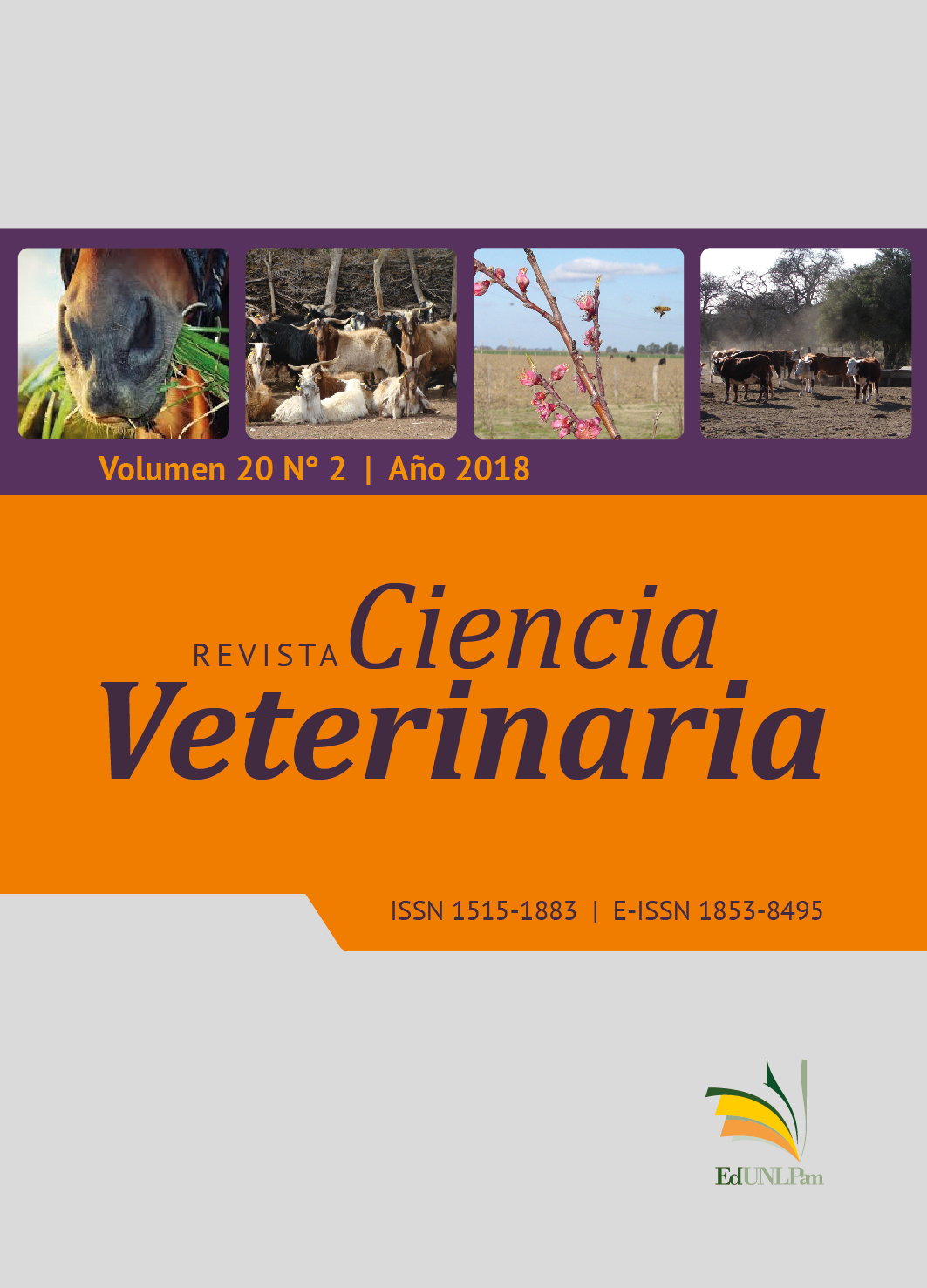Stocking density and productive traits in an experimental three way cross of free range chicken
DOI:
https://doi.org/10.19137/cienvet-201820204Keywords:
growth, uniformity, body conformation corporal, slaughter traitsAbstract
Campero chicken represents a productive alternative within the framework of semi-intensive poultry systems that seek to preserve animal welfare. The production protocol establishes restrictions linked to management strategies, among which is the maximum stocking density of birds allowed per unit area. The aim of this work was to evaluate the effect of the stocking density on the dynamic growth pattern, the uniformity by precision of body weight, the body conformation and the slaughter traits in male chickens of the experimental three way cross Campero Casilda. Birds were bred as a single group, in confinement, until 35 days, when they were randomly distributed in three treatments: Low Density: 6 birds / m2 (21 kg / m2), Recommended Density: 7 birds / m2 (24.5 kg / m2) and High Density: 8 birds / m2 (28 kg / m2) and access to the park was enabled until slaughter at 84 days. Within the limits tested in this work, neither the decrease in the
density indicated by the protocol of production of Campero chickens, in search of greater welfare, nor its increase, in search of greater profitability, significantly affect body growth evaluated from the dynamic pattern of body weight and the record of conformation indicators based on linear measurements. Neither body weight uniformity nor the
proportion of valuable cuts of butcher interest, abdominal fat content and carcass yield at slaughter, of Campero Casilda males, were affected. The evidence shows that the increase of stocking density does not produce detrimental effects on those traits of greater economic importance, in particular, body weight and traits at slaughter, for what a modification in this sense could be introduced in the protocol tending to favor the economic return in productive enterprises
Downloads
References
Dottavio, A.M., Amoroto, I., Romera, B.M., Álvarez, M., Canet, Z.E., Di Masso,
R.J. Conformación corporal en poblaciones de pollos para carne con diferente
velocidad de crecimiento. Revista FAVE - Ciencias Veterinarias. 2010; 9
(2), 25-36.
Bonino, M.F. Pollo Campero. Protocolo para la certificación. INTA. EEA Pergamino.1997.
Sauveur, B. Les critères et facteurs de la qualité des poulets Label Rouge.
INRA Prod. Anim. 1997; 10 (3): 219-226.
Savoy, J.P.; Canet, Z.E.; Dottavio, A.M.; Antruejo, A.E.; Di Masso, R.J. Dimorfismo
sexual para peso corporal temprano y tasa de crecimiento exponencial
pre-inflexión en pollos Campero Casilda. Actas VIII Jornada de Ciencia y Tecnología de la Universidad Nacional de Rosario. 2014.
Canet, Z.E.; Savoy, J.P.; Antruejo, A.E.; Martines, A.; Romera, B.M; Dottavio,
A.M; Di Masso, R.J. Dimorfismo sexual para crecimiento dimensional en el hí-
brido experimental de tres vías Campero Casilda. Actas XIX Congreso y XXXVII
Reunión Anual de la Sociedad de Biología de Rosario. 2017 Disponible
en: https://www.sbr.org.ar/libros.php (Consultado 25/09/2018)
Librera, J.E.; Álvarez, M.; Lucach, S.; Serrano, C.; Velázquez, J.; Canet, Z.E.; Dottavio, A.M.; Di Masso, R.J. Comportamiento del dimorfismo sexual en peso
corporal en función de la edad en híbridos experimentales de pollos camperos.
Actas XIV Congreso Sociedad de Biología de Rosario. 2012. Disponible
en: https://www.sbr.org.ar/libros.php (Consultado 25/09/2018)
Serrano, C.; Lucach, S.; Fernández, R.; Librera, J.E.; Dottavio, A.M.; Di Masso,
R.J.. Estudio longitudinal del peso corporal en machos y hembras de dos hí-
bridos experimentales de pollo campero. En: Actas XIV Jornadas de Divulgación
Técnico-Científicas. Facultad de Ciencias Veterinarias, UNR. Casilda
(Santa Fe) 27 de agosto de 2013. Disponible en: https://fveter.unr.edu.ar/
jornadas/ (Consultado 25/09/2018)
García, R.G., Mendes, A.A., García, E.A., Nääs, I.A., Moreira, J., Almeida, I.C.L., y
Takita, T.S..Efeito da densidade de criação e do sexo sobre o empenamento,
incidência de lesões na carcaça e qualidade da carne de peito de frangos de
corte. Braz. J. Poult. Sci. 2002; 4 (1), 1-9.
Lima, A.; Nääs, I. Evaluating two systems of poultry production: Conventional
and Free-Range. Braz. J. Poult. Sci. 2005; 7 (4): 215-220.
Thomas, D.G.; Ravindran, V.; Thomas, D.V.; Camden, B.J.; Cottam, Y.H.; Morel,
P.C.; Cook, C.J. Influence of stocking density on the performance, carcass characteristics and selected welfare indicators of broiler chickens. N. Z. Vet. J.
; 52 (2): 76-81.
Estevez, I. Density allowances for broilers. Where to set the limits? Poult. Sci.
; 86 (6):1265–1272.
Skrbic, Z.; Pavlovski, Z.; Lukié, M. Stocking density. Factor of production performance, quality and broiler welfare. En: Biotechnology in Animal Husbandry.
; 25 (5-6): 359-372.
Fitzhugh, H. Analysis of growth curves and strategies for altering their shape.
J. Anim. Sci. 1976; 42 (4): 1036-1051.
Sheskin D. Handbook of parametric and nonparametric statistical procedures.
Chapman & Hall, USA, 2011.
Toudic C. Evaluating uniformity in broilers. Hubbard Technical Bulletin. June
https://www.hubbardbreeders.com/media/evaluating_uniformity_
in_broilers__factors_affecting_variation__june_2006__019812700_1448_060
pdf (Consultado 25/09/2018)
Aviagen. Manual de manejo del pollo de carne Ross (pág.72). 2010 Disponible
(Consultado25/09/2018)
Vanhonacker, F.; Verbeke, W.; Van Poucke, E.; Buijs, S.; Tuyttens, F.A.M.. Societal concern related to stocking density, pen size and group size in farm
animal production. Livest. Sci. 2009; 123 (1):16–22.
Buijs, S.; Keeling, L.; Rettenbacher, S.; Van Poucke, E.; Tuyttens, F.A. Stocking
density effects on broiler welfare: identifying sensitive ranges for different
indicators. Poult Sci 2009; 88 (8):1536-1543.
Librera, J.E.; Di Masso, R.J.; Canet, Z.E.; Font, M.T.; Dottavio, A.M. Crecimiento,
consumo de alimento y eficiencia alimenticia en pollos Campero INTA
con diferente genotipo materno. Revista FAVE – Sección Ciencias Veterinarias.2003; 2 (1): 71-78.
Dottavio, A.M.; Librera, J.E.; Romera, B.M.; Font, M.T.; Di Masso, R.J. Eficiencia
de conversión de híbridos experimentales para la producción de pollo campero.
Revista FAVE – Sección Ciencias Veterinarias. 2008; 7 (1-2): 7-15
Dottavio, A.M.; Fernández, R.; Librera, J.E.; Martines, A.; Advínculo, S.A.; Antruejo, A.E.; Canet, Z.E.; Di Masso, R.J. Eficiencia alimenticia en machos y
hembras de dos híbridos experimentales de tres vías de pollos camperos.
Revista Ciencia Veterinaria. 2013; 15 (1): 25-38.
Dozier, W.; Thaxton, J.P.; Purswell, J.L.; Olanreaju, H.A.; Branton, S.L.; Roush,
W.B. Stocking density effects on male broilers Brown to 1.8 kilograms of
body weight. Poult. Sci. 2006; 85 (2): 344-351.
Dawkins, M.S.; Donnelly, C.A.; Jones, T.A. Chicken welfare is influenced more
by housing conditions than by stocking density. Nature. 2004; 427 ( 6972): 342-344.
Downloads
Published
Issue
Section
License
Al momento de enviar sus contribuciones, los colaboradores deberán declarar , de manera fehaciente, que poseen el permiso del archivo o repositorio donde se obtuvieron los documentos que se anexan al trabajo, cualquiera sea su formato (manuscritos inéditos, imágenes, archivos audiovisuales, etc.), permiso que los autoriza a publicarlos y reproducirlos, liberando a la revista y sus editores de toda responsabilidad o reclamo de terceros , los autores deben adherir a la licencia Creative Commons denominada “Atribución - No Comercial CC BY-NC-SA”, mediante la cual el autor permite copiar, reproducir, distribuir, comunicar públicamente la obra y generar obras derivadas, siempre y cuando se cite y reconozca al autor original. No se permite, sin embargo, utilizar la obra con fines comerciales.








.jpg)

4.png)


7.png)



